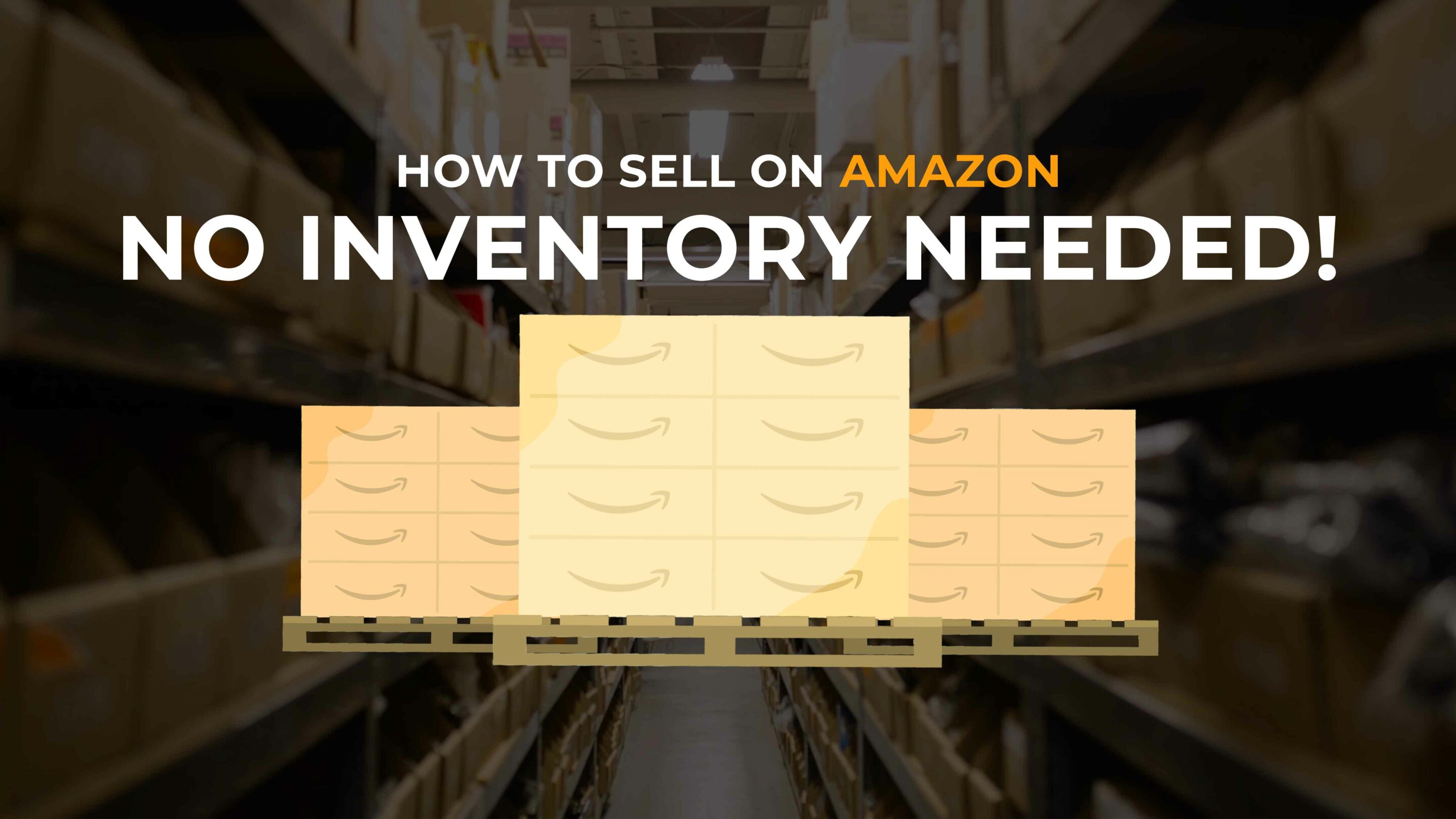
Imagine this: It’s a bright Monday morning. You’re sipping your favorite coffee, casually checking your emails. There’s a new notification – yet another sale on Amazon. But here’s the twist – your living room isn’t cluttered with boxes, there’s no frantic packaging, no post office runs. This isn’t a distant dream; it’s the reality of selling on Amazon without inventory.
Welcome to the world where your entrepreneurial spirit meets the marvels of modern e-commerce – a world where your business thrives without the traditional hassles of stock management. In this blog post, we’re deep diving into the realm of selling on Amazon without the need for physical inventory. Whether you’re a seasoned seller eyeing expansion or a budding entrepreneur dipping your toes into online business, this guide is your roadmap to mastering the art of inventory-free selling.
Join us as we unravel the secrets of leveraging Amazon’s colossal platform to your advantage, all without the traditional burdens of inventory management. Ready to transform your Monday mornings? Let’s get started.
Jump right in: How to Sell on Amazon Without Inventory
- Explaining the Concept – How To Sell on Amazon Without Inventory
- The Role of Third-Party Fulfillment
- Overview of Different Selling Methods
- Product Selection for Inventory-Free Selling on Amazon
- Setting Up Your Amazon Seller Account – A Step-by-Step Guide
- How to Excel in Customer Service
- Managing and Optimizing Amazon Sales
- Debunking Common Myths About Selling on Amazon Without Inventory
- Importance of FBA Prep and Fulfillment Services
- Summary and Key Take-Aways
Explaining the Concept – How To Sell on Amazon Without Inventory
If you’re like many aspiring entrepreneurs, the idea of starting an online business is exciting, but the thought of dealing with physical inventory might be daunting. Well, what if I told you that you could run a successful Amazon business without ever touching a product? Welcome to the world of selling on Amazon without inventory.
The No-Inventory Model: A New Age of E-commerce
This model, at its core, is about leveraging existing systems and technologies to sell products without the traditional burdens of inventory management. It’s a shift from the conventional approach where you stockpile goods in a warehouse. In the no-inventory model, you’re essentially the middleman between the supplier and the customer, but with a twist – you use powerful platforms like Amazon to reach a vast audience.
Why Go Inventory-Free?
Here’s why this approach is gaining traction:
- Lower Start-Up Costs: No need to invest heavily in stock, which means you can start with a relatively small budget.
- Less Risk: Holding inventory comes with risks like slow moving stock or outdated products. Selling without inventory minimizes these risks.
- Flexibility and Scalability: You can quickly test different products and scale your business without being tied down by physical stock.
- Global Reach: Amazon’s global presence means you can sell to customers worldwide without worrying about international shipping logistics.
The Challenges – It’s Not All Smooth Sailing
While selling on Amazon without inventory has its perks, it’s not without challenges:
- Dependence on Suppliers: Your success hinges on the reliability of your suppliers. Delays or quality issues can directly impact your business.
- Intense Competition: This model is attractive, which means you’ll face stiff competition. Standing out requires smart strategies and a deep understanding of the Amazon marketplace.
- Complex Logistics: Managing the logistics of shipping, returns, and customer service can be challenging, especially when you don’t control the inventory.
Traditional vs. Inventory-Free Selling on Amazon
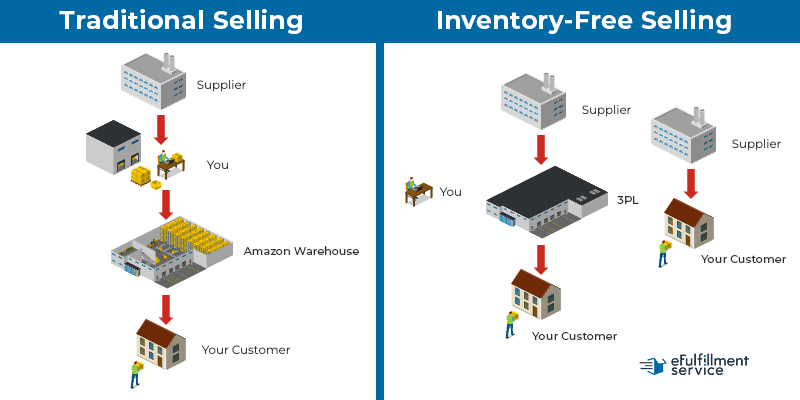
Let’s compare:
Traditional Selling: You buy products, store them, manage inventory, and ship them to customers. It requires more capital and hands-on management but offers more control over the shipping process and customer experience.
Inventory-Free Selling: You don’t hold products. Instead, when a customer orders, you purchase the product from a third party who ships it directly to the customer. Your focus is on market research, product selection, and optimizing your Amazon listing.
The Role of Third-Party Fulfillment in Inventory-Free Amazon Selling
Now that you’re familiar with the concept of selling on Amazon without holding any inventory, let’s dive into a crucial component that makes this all possible: third-party fulfillment. This is where the magic happens in the background, allowing you to run your business smoothly without worrying about the logistics of storing, packing, and shipping products.
Understanding Third-Party Fulfillment
Third-party fulfillment, in simple terms, is when you outsource your storage and shipping needs to another company. They handle the heavy lifting of logistics, while you focus on the front-end aspects of your business, like market research and customer engagement.
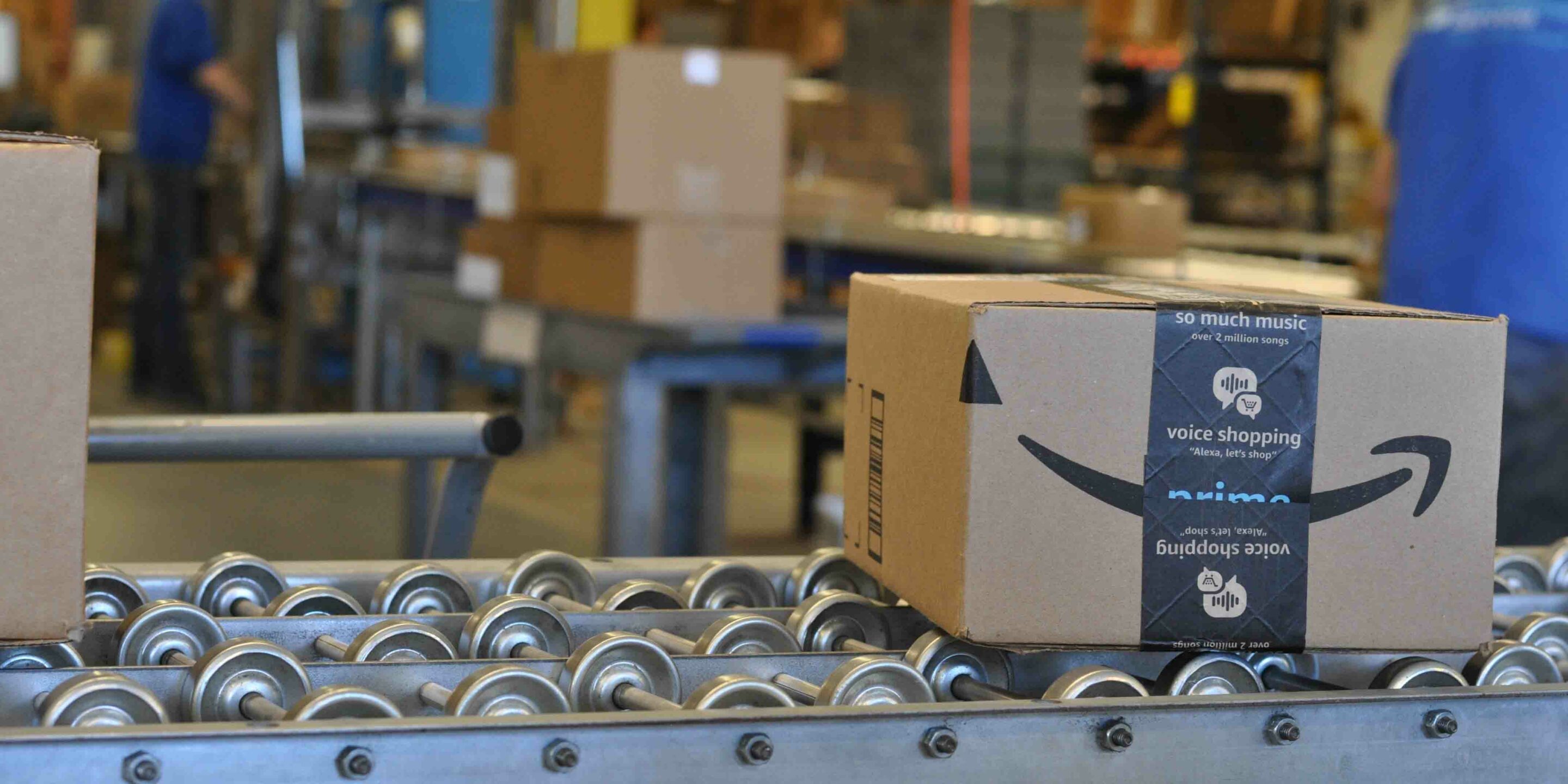
Why Third-Party Fulfillment is a Game Changer
- Efficiency: These fulfillment services have the infrastructure and expertise to manage logistics more efficiently than you probably could on your own.
- Scalability: As your business grows, third-party fulfillment services can easily scale to meet the increased demand without you needing to change much on your end.
- Global Reach: They often have multiple fulfillment centers worldwide, allowing you to sell internationally without the complexities of international shipping.
Amazon FBA: A Prime Example
Amazon’s own Fulfillment by Amazon (FBA) program is the epitome of third-party fulfillment. Here’s how it works:
- You send your products to Amazon’s fulfillment centers.
- Amazon stores your inventory.
- When a customer places an order, Amazon picks, packs, and ships the product on your behalf.
- They also handle customer service and returns for these orders.
FBA is particularly appealing because it integrates seamlessly with your Amazon sales, offering benefits like Prime eligibility, which can significantly boost your sales.
Alternatives to Amazon FBA
While FBA is a popular choice, it’s not the only one. Other third-party fulfillment services such as eFulfillment Service can offer more flexibility, different pricing models, or additional services that Amazon doesn’t provide. When choosing a third-party service, consider factors like pricing, location of their warehouses, and the specific needs of your product type.
Balancing Cost and Convenience
Using third-party fulfillment services isn’t free, and it’s essential to balance the cost against the convenience and efficiency they offer. Consider factors like storage fees, fulfillment fees, and any additional services (like kitting or custom packaging) that might impact your bottom line.
The Impact on Customer Experience
Remember, even though you’re not handling the physical products, customer experience is still in your hands. Choosing a reliable fulfillment partner is crucial because late shipments or damaged products can reflect poorly on your business.
Overview of Different Selling Methods on Amazon Without Inventory
Embarking on your Amazon selling journey without inventory means understanding the different methods available to you. Each method has its unique characteristics, advantages, and strategies. Let’s break down the most popular methods: dropshipping, Fulfillment by Amazon (FBA), and Fulfillment by Merchant (FBM).
Dropshipping: The Ultimate Inventory-Free Model
Dropshipping is the epitome of selling without inventory. Here’s how it works:
- Product Listing: You list products for sale on Amazon.
- Customer Orders: When a customer places an order, you purchase the product from a third party (usually a wholesaler or manufacturer).
- Direct Shipping: The third party ships the product directly to the customer.
Pros:
- Minimal upfront investment.
- No need to handle products physically.
- Flexibility in product offerings.
- No need for packaging stock
- Lower financial risk
Cons:
- Less control over shipping and inventory.
- Slimmer profit margins.
- Dependency on supplier reliability.
- Still need to handle your own customer service and returns.
Amazon FBA: Let Amazon Do the Heavy Lifting

With FBA, you send your products to Amazon’s fulfillment centers, and they take care of the rest.
Pros:
- Eligibility for Amazon Prime, increasing customer trust and likelihood of purchase.
- Amazon handles customer service and returns.
- Access to Amazon’s massive customer base.
- You benefit from being able to ship at Amazon’s discounted shipping rates.
Cons:
- Upfront investment in inventory is required.
- Storage and fulfillment fees can add up.
- You need to manage inventory levels at Amazon’s warehouses.
- Amazon controls the quantity that you can ship into their warehouses.
- Vendors must ship stock using Amazon labeling requirements.
- May get hit with peak storage rates or remove your inventory during the peak Holiday Season.
Amazon FBM: You’re in Control

Fulfillment by Merchant (FBM) is another option where you list products on Amazon but handle the fulfillment process yourself or through a third-party fulfillment service (other than Amazon).
Pros:
- More control over the packing and shipping process.
- Potentially higher profit margins as you’re not paying Amazon’s FBA fees.
- Flexibility in shipping and handling, especially for unique or fragile items.
- Do not have to remove slower-selling items during the peak season.
- Able to provide their own customer service to the end recipient.
Cons:
- More time-consuming as you’re responsible for fulfillment.
- Not eligible for Prime by default (unless you qualify for Seller Fulfilled Prime).
- Requires infrastructure for storage and shipping if not using a third-party service.
Choosing the Right Method for You
Selecting the right method depends on various factors like your budget, business goals, product type, and personal preferences. For instance, dropshipping might be ideal for those looking to start with minimal investment. In contrast, FBA could be a better fit if you have some capital and want to leverage Amazon’s fulfillment network and Prime eligibility.
In the next section, we’ll delve into the crucial aspect of product selection, which can make or break your success in any of these methods. Picking the right products is not just about what you think will sell but understanding market trends, customer needs, and Amazon’s policies.
Fulfill your Amazon Orders Easily!
Get a FREE quote from eFulfillment Service to see how we could help simplify your Amazon order fulfillment.
The Art of Product Selection for Inventory-Free Selling on Amazon
Selecting the right product is the linchpin of success when selling on Amazon without inventory. It’s a blend of art and science — understanding market trends, customer desires, and the nuances of Amazon’s marketplace. Let’s dive into strategies to help you identify profitable products and navigate Amazon’s product policies.
Understanding Market Demand and Trends
Your first step is to gauge market demand. This involves:
- Market Research: Use tools like Jungle Scout, Google Trends, and Amazon’s Best Sellers list to identify trending products.
- Competitive Analysis: Look at what your competitors are selling and how they are positioning their products. Tools like Keepa and CamelCamelCamel can provide historical pricing and sales data.
Finding Your Niche
Choosing a niche market can significantly increase your chances of success:
- Focused Target Audience: A niche market allows you to target a specific audience, making your marketing efforts more effective.
- Less Competition: Niche products often have less competition than more mainstream items.
- Expertise and Authority: Selling in a niche market allows you to build expertise and authority, leading to customer trust and loyalty.
Balancing Quality and Profitability
Select products that balance quality and profitability:
- High-Quality Products: Ensure the products you choose are of good quality. Poor-quality products can lead to negative reviews and returns.
- Profit Margin Consideration: Consider the cost of goods, Amazon fees, shipping costs, and any third-party fulfillment charges to ensure a healthy profit margin.
Complying with Amazon’s Policies and Restrictions
Amazon has strict policies and restrictions on what can be sold:
- Prohibited Products: Familiarize yourself with Amazon’s list of restricted and prohibited items.
- Quality Standards: Ensure that your products meet Amazon’s quality standards to avoid account suspensions.
The Role of Supplier Relations in Product Selection
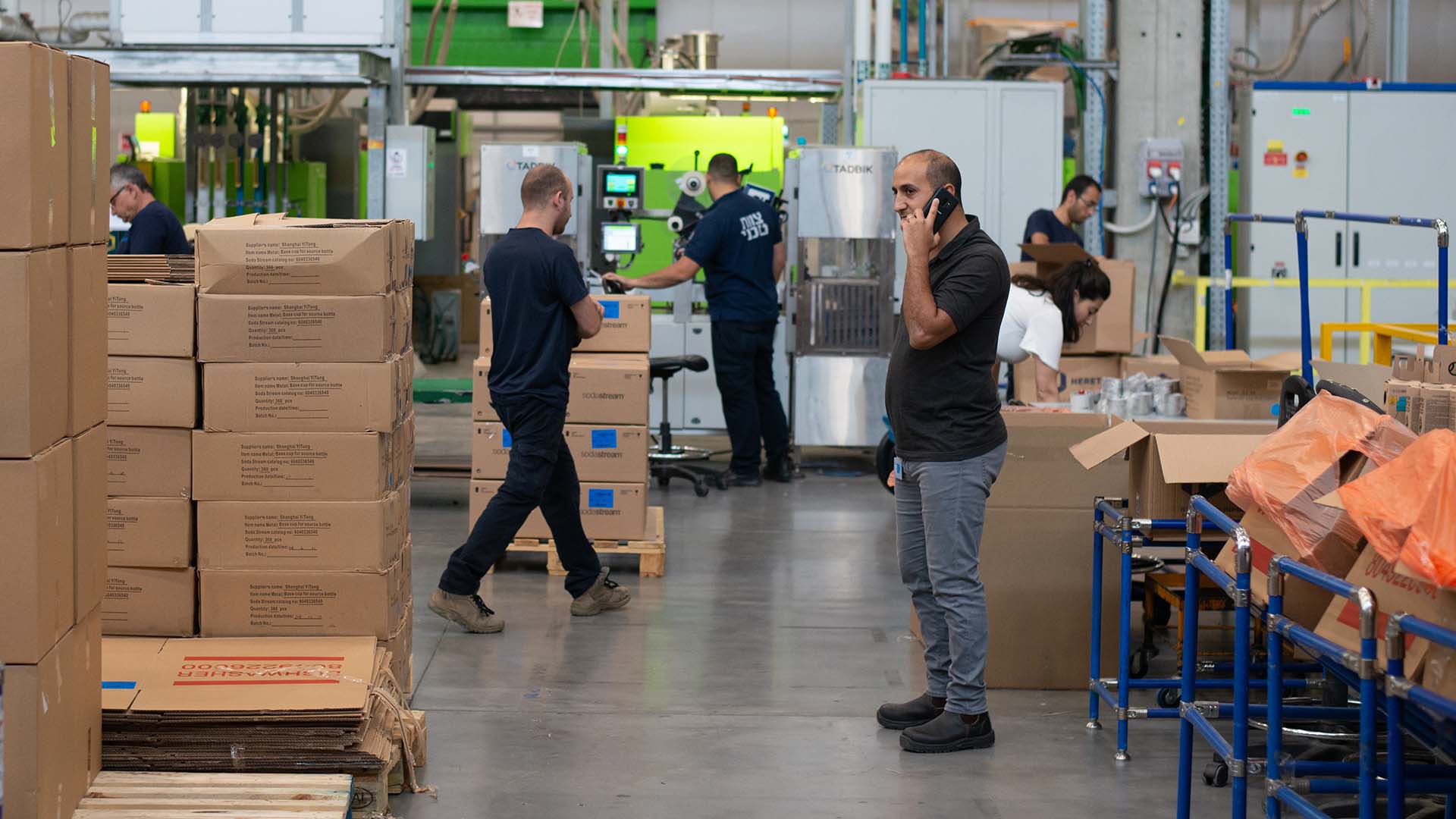
Building a good relationship with suppliers is crucial, especially in dropshipping:
- Reliable Suppliers: Ensure your suppliers are reliable and can provide consistent product quality and timely shipping.
- Negotiating Terms: Good supplier relationships can lead to better pricing, exclusive deals, or more favorable terms.
Setting Up for Success
- Start Small: Begin with a small range of products to test the market and gradually expand.
- Customer Feedback: Pay attention to customer feedback and reviews to understand their needs and adjust your product selection accordingly.
In the next section, we will guide you through setting up your Amazon seller account, a critical step in starting your journey in selling on Amazon without inventory. This will include insights into the practicalities of account setup and essential considerations to ensure you start on the right foot.
Setting Up Your Amazon Seller Account – A Step-by-Step Guide
Launching your journey on Amazon begins with setting up your seller account. This process is straightforward, but it’s crucial to get it right to avoid any hiccups down the road. Here’s your step-by-step guide to setting up your Amazon seller account, tailored for inventory-free selling.
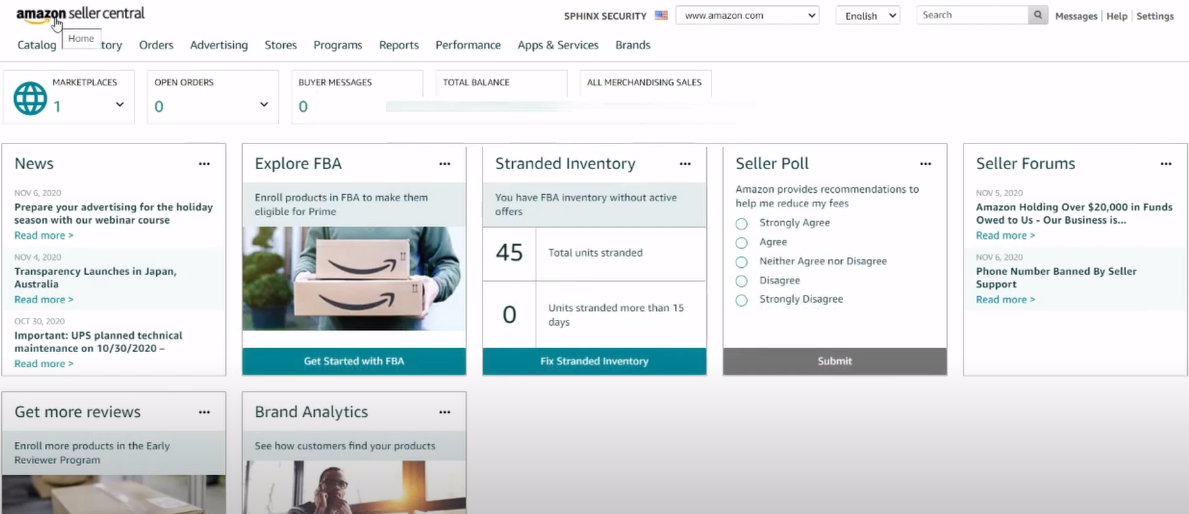
Step 1: Choose Your Seller Plan
Amazon offers two types of seller accounts: Individual and Professional.
- Individual Plan: Best for sellers planning to sell fewer than 40 items per month. You pay $0.99 per sale, but this plan has limited features.
- Professional Plan: Suitable for higher volume selling, with a monthly fee of $39.99 but no per-item fee. This plan offers additional tools and the ability to sell in restricted categories.
Step 2: Register Your Account
- Visit Amazon Seller Central: Go to Amazon Seller Central and click on ‘Register now’.
- Provide Business Information: Enter your business name, address, and contact information. If you don’t have a registered business, you can start as a sole proprietor using your personal information.
- Tax Information: Complete the tax interview process. This is crucial for legal compliance and receiving payments from Amazon.
Step 3: Set Up Payment Information
- Bank Account Details: Enter your bank account details where Amazon will deposit your sales earnings.
- Credit Card Information: Provide a valid credit card that Amazon will use for charging your seller fees.
Step 4: Create Your Storefront
- Brand Name and Logo: Choose a brand name and logo that represents your store. This is key for branding and building customer trust.
- Store Description: Write a compelling description that outlines your store’s unique selling points and what customers can expect.
Step 5: Understanding Amazon’s Seller Policies
- Seller Policies: Familiarize yourself with Amazon’s seller policies to ensure you comply with their rules and regulations.
- Performance Metrics: Understand Amazon’s performance metrics, as maintaining good standing is crucial for your store’s success.
Step 6: Listing Your Products
- Product Listings: Start listing your products. Ensure that your listings are detailed, with high-quality images and accurate descriptions.
- SEO Optimization: Optimzing your Amazon SEO is crucial to get your products infront of potential customers. Utilize relevant keywords in your product titles and descriptions to improve visibility in Amazon searches.
Step 7: Managing Your Account
- Dashboard Monitoring: Regularly check your Seller Central dashboard for insights into your sales, customer feedback, and inventory levels.
- Continuous Learning: Stay updated with Amazon’s updates and new tools that can help optimize your selling experience.
Step 8: Planning for Growth
- Expansion Strategy: As your business grows, consider expanding your product line, exploring different fulfillment methods, or tapping into international markets.
Setting up your Amazon seller account is the foundation upon which your business will grow. Each step is an opportunity to establish yourself effectively on this global platform. In the next section, we’ll dive into the importance of customer service in selling without inventory, and how maintaining high standards can significantly impact your success on Amazon
Excelling in Customer Service While Selling on Amazon Without Inventory
When you sell on Amazon without inventory, you might not handle the products, but you’re still in charge of customer service. Stellar customer service can set you apart from competitors, leading to repeat customers and positive reviews, which are gold on Amazon. Here’s how to excel in customer service in this unique selling model.

Understand the Importance of Customer Service
Building Brand Reputation: Good customer service helps build a strong brand reputation, essential for long-term success.
Impact on Reviews and Ratings: Positive customer experiences often translate into favorable reviews and ratings, crucial for attracting new customers.
Responding to Customer Inquiries
- Prompt Responses: Always respond to customer inquiries quickly. Amazon tracks response times, and it’s a key metric for customer satisfaction.
- Clear and Helpful Answers: Ensure your responses are clear, helpful, and address the customer’s concerns or questions fully.
Handling Order Issues
- Proactive Issue Resolution: If there’s an issue with an order, be proactive in resolving it. This includes reaching out to suppliers or third-party fulfillment services to rectify any problems.
- Empathy and Understanding: Always approach customer complaints with empathy. Understand their frustration and work towards a satisfactory resolution.
Managing Returns and Refunds

- Clear Return Policy: Have a clear return and refund policy that complies with Amazon’s guidelines.
- Hassle-Free Returns: Make the return process as hassle-free as possible. This can turn a potentially negative experience into a positive one.
Seeking and Utilizing Feedback
- Encourage Feedback: Encourage customers to leave feedback. This not only provides social proof for future customers but also gives you insights into what you’re doing right or wrong.
- Act on Feedback: Use customer feedback to improve your product selection, listing accuracy, and overall customer experience.
Leveraging Amazon’s Tools
- A-to-z Guarantee: Familiarize yourself with Amazon’s A-to-z Guarantee to understand how it protects customers and impacts sellers.
- Automated Customer Service Tools: Utilize Amazon’s automated tools to manage common customer service tasks efficiently.
Training and Resources
- Stay Informed: Keep yourself informed about best practices in customer service. Amazon offers resources and training that can be invaluable.
- Outsource if Necessary: If customer service becomes overwhelming, consider outsourcing to virtual assistants or professional services specialized in Amazon seller support.
Excelling in customer service is crucial, especially in a model where the customer doesn’t interact with you physically. It’s your direct line to your customers and a critical component of your success on Amazon. In the next section, we’ll explore strategies for managing and optimizing your Amazon sales, an ongoing process that requires attention and adaptability to thrive in the competitive Amazon marketplace.
Interested making your work life easier?
Contact us and we’ll tell you how we can improve your fulfillment experience and efficiency.
Managing and Optimizing Amazon Sales Without Inventory
Now, let’s talk about a crucial aspect that often gets overlooked by new sellers on Amazon: managing and optimizing your sales. This isn’t just about making your first few sales; it’s about sustaining and growing your business in a highly competitive market. So, how do you keep your Amazon store running like a well-oiled machine? Let’s dive in.
Regular Account Management: The Key to Consistency
First things first, you need to stay on top of your Amazon account. This means regularly checking your inventory levels, monitoring your sales performance, and staying updated with Amazon’s policies. Consistency is key here. You don’t want to run into situations where popular items are out of stock, or your listings are not compliant with Amazon’s ever-changing rules.
Data-Driven Decision Making
Amazon provides a wealth of data through its Seller Central platform. Use this data to your advantage. Analyze your sales patterns to understand what products are doing well and which ones aren’t. Look for trends, like seasonal spikes in certain products, and plan your inventory and marketing strategies accordingly.
Leverage Tools for Tracking and Increasing Sales
Tools like Keepa and CamelCamelCamel offer insights into price histories and market trends on Amazon. Use these tools to set competitive prices and spot opportunities for new products. Another essential tool is Jungle Scout, which helps in product research and tracking competitors’ performance. These tools are invaluable for making informed decisions that can boost your sales.
Optimizing Product Listings
Your product listings are your storefront. To draw in customers, they need to be optimized. This means:
- High-Quality Images: Clear, high-resolution images that showcase your product.
- Compelling Descriptions: Detailed, keyword-rich descriptions that tell customers everything they need to know.
- Effective Keywords: Use relevant keywords in your titles and descriptions to improve search visibility.
Dynamic Pricing Strategies
Pricing on Amazon can be a game-changer. It’s not just about being the cheapest. It’s about finding the right balance between profitability and competitiveness. Consider using dynamic pricing tools that automatically adjust your prices based on market conditions and competition.
Managing Customer Feedback

Customer reviews are gold on Amazon. Actively manage your customer feedback. Address negative reviews promptly and professionally. Encourage satisfied customers to leave positive reviews. This not only improves your reputation but also influences your product’s ranking on Amazon.
The Power of Amazon Advertising
Don’t underestimate Amazon’s advertising platform. Sponsored Products and Sponsored Brands can significantly increase your product’s visibility. Use targeted ads to reach potential customers who are searching for products like yours.
Continuous Learning and Adaptation
The Amazon marketplace is always evolving. What worked yesterday may not work tomorrow. Stay informed about the latest trends and best practices. Attend webinars, join seller forums, and read up on the latest strategies.
Remember, managing and optimizing your Amazon sales is an ongoing process. It requires attention to detail, a willingness to adapt, and a strategic approach to leveraging the tools and resources at your disposal. With the right tactics, you can not only sustain your Amazon business but also scale it to new heights. Keep these tips in mind, and you’ll be well on your way to becoming a successful Amazon seller, without the burden of inventory management.
Debunking Common Myths About Selling on Amazon Without Inventory
As we venture further into the realm of selling on Amazon without inventory, it’s crucial to clear the air on some prevalent myths. These misconceptions can be roadblocks to your success if you don’t approach them with the right mindset. Let’s debunk them, shall we?
Myth #1: Amazon FBA is Too Complex to Understand
Reality: Sure, Amazon’s Fulfillment by Amazon (FBA) program has its complexities, but it’s far from incomprehensible. Think of FBA like a puzzle; initially, it seems intricate, but once you understand how the pieces fit together, it becomes manageable. There are numerous resources, guides, and tools available to help you navigate FBA. The trick is not to get overwhelmed and take it one step at a time.

Myth #2: It’s Possible to Become a Millionaire Overnight
Reality: Overnight success stories are more myth than reality. Like any business, selling on Amazon requires patience, effort, and smart strategies. Success doesn’t happen overnight; it’s the result of consistent effort, learning from mistakes, and adapting to the market. Set realistic expectations and be prepared for a journey, not a sprint.
Myth #3: There are Too Many Sellers Already on Amazon
Reality: Yes, the platform is competitive, but that shouldn’t deter you. The beauty of Amazon is its vast customer base and the endless variety of niches. With the right product and strategy, there’s always room for new sellers to succeed. Instead of being intimidated by competition, focus on carving out your niche and delivering value to your customers.
Myth #4: You Can Only Sell by Going With the Lowest Prices
Reality: Competing on price alone is a race to the bottom that you don’t want to win. The key to success on Amazon isn’t just having the lowest prices but offering the best value. This can mean superior product quality, better customer service, or a unique selling proposition. Understand your market and price your products smartly to ensure profitability and competitiveness.
Myth #5: Inventing New Products is Necessary to Succeed on Amazon
Reality: Innovation is great, but it’s not the only path to success. Many successful Amazon sellers thrive by selling existing products with a new twist or better marketing. It’s more about finding a niche with demand and less about reinventing the wheel. Research, understand your audience, and find ways to meet their needs effectively.
As you can see, selling on Amazon without inventory is shrouded in myths that can easily be debunked with a bit of research and the right approach. Don’t let these misconceptions hold you back. With clarity and a solid strategy, you’re well on your way to carving out your success story on Amazon. Next up, we’ll look at the importance of FBA Prep and fulfillment services, and why they could be the game-changer in your Amazon venture.
Simplify Selling on Amazon without Inventory!
Get a free quote from eFulfillment Service and see how a 3PL could simplify your FBA Prep and Fulfillment!
Importance of FBA Prep and Fulfillment Services
In the world of selling on Amazon without inventory, Fulfillment by Amazon (FBA) stands out as a game-changer. But, to really make the most of this service, understanding and effectively managing FBA Prep and fulfillment services is crucial. Let’s break down why these are pivotal for your Amazon success.
FBA Prep: The Unsung Hero of Amazon Selling
Think of FBA Prep as the behind-the-scenes workhorse of your Amazon business. It involves preparing your products according to Amazon’s strict guidelines before they’re sent to an Amazon fulfillment center. This includes tasks like packaging, labeling, and ensuring products are ready for safe and efficient shipping.
Why is FBA Prep so important?
- Compliance: Amazon has specific requirements for how items should be packaged and labeled. Failure to comply can lead to rejected shipments, additional fees, or even suspension of your selling privileges.
- Efficiency: Properly prepped items move smoothly through Amazon’s fulfillment process, leading to faster shipping times and happier customers.
- Quality Control: Good FBA Prep means your products are well-protected, reducing the likelihood of damage during shipping and returns.
The Benefits of Outsourcing FBA Prep and Fulfillment Services
As a savvy online entrepreneur, you should consider outsourcing FBA Prep and fulfillment for several reasons:
- Time-Saving: Outsourcing frees up your time to focus on other aspects of your business, like product research and marketing.
- Expertise: Professional prep services are well-versed in Amazon’s guidelines and can ensure compliance, reducing the risk of errors.
- Scalability: As your business grows, these services can easily scale up to handle increased volumes, something that can be challenging if you’re doing it all on your own.
Choosing the Right FBA Prep Service
When selecting an FBA Prep service, consider:
- Experience and Reliability: Look for a service with a proven track record of handling Amazon FBA Prep.
- Cost-Effectiveness: Compare pricing but be wary of services that are too cheap – they might cut corners.
- Flexibility: Can they handle a range of products? Are they adaptable to changes in Amazon’s policies?
Mastering FBA Prep and leveraging fulfillment services effectively can set you apart in the competitive Amazon marketplace. Whether you choose to manage it yourself or outsource, the goal is clear – ensure your products are prepped perfectly, comply with Amazon’s standards, and are ready to delight your customers.
Want to Simplify FBA Prep for fulfilling Amazon orders?
Get a FREE QUOTE from eFulfillment Service today to see how we can help smooth out your FBA Prep!
Conclusion – Embarking on Your Amazon Journey
As we wrap up this comprehensive guide on how to sell on Amazon without inventory, let’s take a moment to reflect on what we’ve covered and the exciting journey that lies ahead of you.
Summarizing the Key Takeaways
The No-Inventory Model: We’ve explored how selling on Amazon without inventory is not only possible but also a smart, low-risk way to enter the world of e-commerce. This model offers flexibility, scalability, and the ability to test different markets without the burden of stock management.
Understanding Amazon’s Ecosystem: From setting up your seller account to choosing the right products and understanding Amazon’s policies, we’ve delved into the nuts and bolts of making your mark on this massive platform.
The Power of FBA and Third-Party Fulfillment: Services like FBA have revolutionized how we approach online selling, offering incredible resources like storage, packing, and shipping, which are especially beneficial for entrepreneurs who opt for the no-inventory route.
The Crucial Role of FBA Prep: We’ve highlighted the importance of FBA Prep and why getting it right can be the difference between success and failure on Amazon.
Your Next Steps
Now that you’re armed with knowledge, what’s next? Here’s what you should do:
- Start Small: Begin with a niche market and a few products to test the waters.
- Utilize Tools: Make the most of tools like Jungle Scout, Keepa, and Alibaba to help you make informed decisions.
- Consider Outsourcing: Look into outsourcing FBA Prep and other fulfillment services to streamline your operations and focus on growing your business.
Final Thoughts
Selling on Amazon without inventory is a journey filled with learning and growth opportunities. It’s about adapting to the e-commerce landscape, understanding consumer needs, and leveraging the vast resources at your disposal. Remember, success doesn’t happen overnight, but with persistence, innovation, and a keen eye for market trends, you can build a thriving Amazon business.
So, are you ready to take the plunge and start your adventure in the world of Amazon selling? Embrace the challenge, and who knows – you might just be the next big success story we talk about!
Simplify your Amazon Selling!
Get a free quote from eFulfillment Service and see how a 3PL could simplify FBA Prep and Fulfillement!




0 Comments